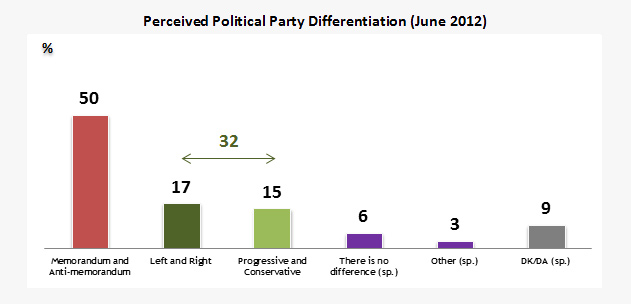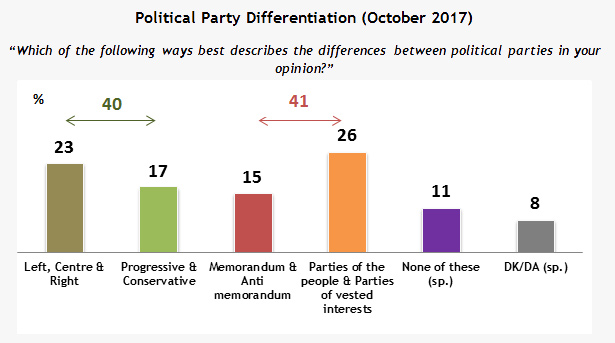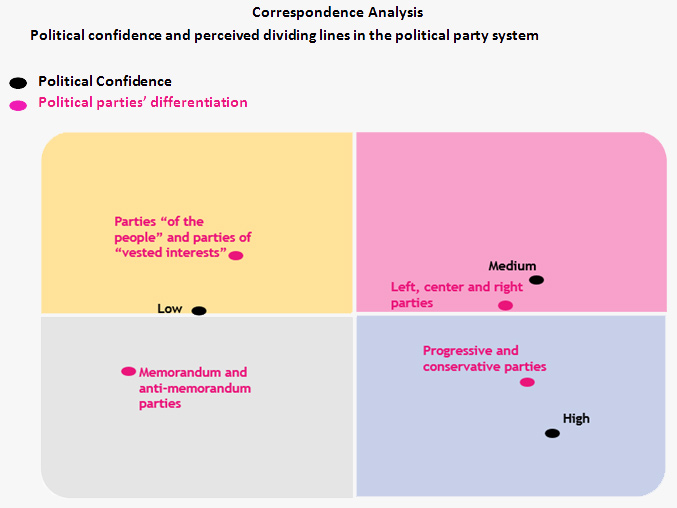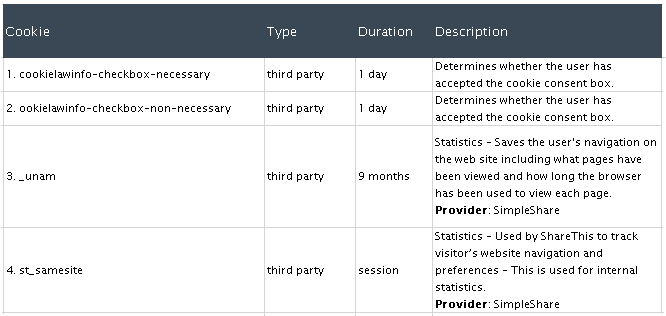The party system and political developments
It is known that the economic crisis that has “hit” Greece since 2009 has gradually led to the collapse of citizens’ trust in the political system and to significant changes in the correlations between political parties. The most important of these changes were the gradual elevation of SYRIZA to a leading party and the shrinking of PASOK, which at some point threatened the party’s participation in Parliament.
These changes were not just an outcome of the shift in political correlations. They were, essentially, a new way of looking at the country and the causes of the crisis, a new way of looking at the political stakes of the time that, among other things, changed the way people perceived the political system and political parties, which are the main actors in the production of policies.
Therefore, in a question on how citizens perceive the differences between political parties, in June 2012 just before the second elections, one out of two respondents (50%) stated, in a Metron Analysis survey, that the main contrast they perceived between parties is the contrast between parties that are for and against the Memorandum (Memorandum/ Anti-memorandum). On the basis of this new perception, a new political majority was formed that overcame the traditional dividing lines between Left and Right, which in a previous historic cycle would have made governmental coalitions such as SYRIZA- ANEL unimaginable.

Today, five years later, the contrast between Memorandum/ Anti-memorandum parties has ceased to be the main interpretation of the dividing lines between parties.
From 50% in 2012, only 15% mentions these terms as being the main dividing line between political parties. However, the remaining 35% that has abandoned this opinion, does not fuel the traditional view of political party differentiations, such as Left- Right or Progressive- Conservative. A significant part of this 35% is turning towards a division based on class (which some see as populist) that takes the form of “parties of the people” / “parties of vested interests”.
Thus, two adjoining, equivalent poles are formed, each one covering approximately 40% of voters. We could describe them schematically as the “systemic” and “anti-systemic” poles.

What remarks can be made?
1.The part of voters that comprehend the political party system based on the traditional terms of Left- Right or Progressive – Conservative terms, has moved from 32% in 2012 to 40% today.
2.A large part of the anti-memorandum forces currently has a perception of the political system that is based on class; this is also largely the basis of the analysis of the anti-systemic parties, as well as the basis of critical perceptions and attitudes, even the rejection of the parliamentary system (such as abstention from the voting procedure etc.) The correspondence analysis scheme that follows shows that the “class” perception of the political party system is closely related to low trust towards politics and that is the reason it can easily coexist with “anti-systemic” attitudes.
3.Furthermore, based on the correspondence analysis that follows, the traditional perception of the political party system is positioned closer to the parliamentary system and to high or medium trust in politics. At this point, we must remember that here political confidence is measured based on trust in the Parliament.

According to the above, it turns out that the retreat of anti-memorandum rhetoric and perceptions as a major political contrast did not happen in favor of a return to traditional perceptions about the function and the political representation relations of the parties; in the contrary, it turned towards more structurally opposing opinions and criticisms of the traditional function of the political party system, when compared to the criticism of memorandum policies. Only a small part of the voters has been added to the traditional way of analysis (from 32% in 2012 to 40% today).
There are many and complex questions that relate to the “next day” of political life in Greece as well as the correlations to be formed. Some of these are:
1.Are there or will there be any political parties that will represent the “anti-systemic” views or will these views remain outside parliamentary logic and participation in elections, as they did in the elections of September 2015?
2.Can the political party system overcome the confidence crisis and renew itself in order to limit phenomena of rejection and extensive distancing, as shown by the low political trust indicators? How will the pre- election debates and narratives develop as we are heading to the ballot? Will SYRIZA represent the forces that wish for a “party of the people” against the “parties of vested interests” or will it try to represent the Left/ progressive pole against the Right/ conservative pole that New Democracy represents?
We will have to wait and see.
Stratos Fanaras










